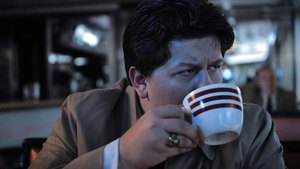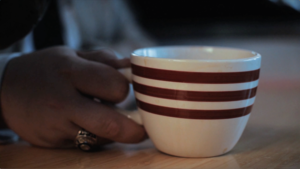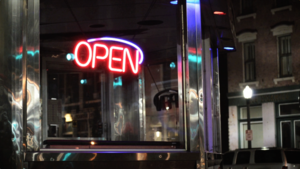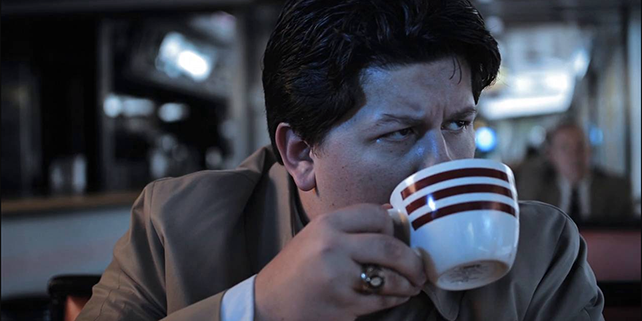Mean Streets and The 24/7 Diner: Pt. 03 – Production
 The heart of any ‘noir-style’ piece, is darkness… night shots… shadows, etc. I was presented with a serious challenge to achieving this look, however, when I secured the diner location. They opened for business at 4pm, and didn’t close until 4am, and we didn’t have it in our budget to close them down for a day. So, this meant that if I wanted to use the diner, I was going to have to shoot during daylight hours. Given that the entire front of the diner was composed of large windows, lighting was going to be a major issue. Essentially, I’d have to shoot ‘day for night’. I hate ‘day for night’ shots, as they never look convincing to me, no matter the budget or talent involved. You can always tell.
The heart of any ‘noir-style’ piece, is darkness… night shots… shadows, etc. I was presented with a serious challenge to achieving this look, however, when I secured the diner location. They opened for business at 4pm, and didn’t close until 4am, and we didn’t have it in our budget to close them down for a day. So, this meant that if I wanted to use the diner, I was going to have to shoot during daylight hours. Given that the entire front of the diner was composed of large windows, lighting was going to be a major issue. Essentially, I’d have to shoot ‘day for night’. I hate ‘day for night’ shots, as they never look convincing to me, no matter the budget or talent involved. You can always tell.
We also didn’t have the luxury of extra time in our schedule, to compensate for the world’s largest light source, should it appear in all it’s radiant glory on our shoot day. We’d have to work faster and smarter, to get what we wanted. I took my videographer to the diner, for lunch, and to get an idea of what needed to be done on our shoot. We felt reasonably confident that between clever lighting and color correction, we’d be able to get the look that we wanted. Nevertheless, we both crossed our fingers for a cloudy shoot day.
 Casting was a little bit easier. The main character was (as always) the most important casting call. I looked through a few options and settled on someone who’d be recommended to me by the client. He was much younger than what I had in mind, but he could give a cold, dead stare… and his voice! Amazing! After hearing it, my first thought was, “what is this guy doing in Cincinnati?”, and I knew I had my guy. The role of the cook was selected, and would also be used in the 2nd spot of the campaign. The role of ‘lonely guy in the back’, was a friend of the client’s, who just wanted to be in the spot. As there were no speaking parts for that role, I was happy to oblige.
Casting was a little bit easier. The main character was (as always) the most important casting call. I looked through a few options and settled on someone who’d be recommended to me by the client. He was much younger than what I had in mind, but he could give a cold, dead stare… and his voice! Amazing! After hearing it, my first thought was, “what is this guy doing in Cincinnati?”, and I knew I had my guy. The role of the cook was selected, and would also be used in the 2nd spot of the campaign. The role of ‘lonely guy in the back’, was a friend of the client’s, who just wanted to be in the spot. As there were no speaking parts for that role, I was happy to oblige.
With casting out of the way, along with wardrobe (pretty straight-forward stuff), I had one element that I wanted to add, specifically for the shoot… coffee cups. I didn’t want the modern day version of coffee mugs that you find in coffee shops and restaurants. The chunky, squarish, plain mugs weren’t going to cut it, and that’s precisely what the restaurant had to offer.  I wanted something that looked like it belonged, while at the same time, having a little flair. It’s a small thing, but if I’ve learned anything in over 25 years of making pictures, it’s that these little elements can go a long way towards selling the whole piece, visually. I thought for sure that I was going to have to hit the antique and consignment shops, to find what I was looking for, but on my way, I decided to hit the local Target store… and lo and behold, there they were. Perfect. Not over the top. They looked like coffee cups from another era. $10 or so later, I walked with two of them.
I wanted something that looked like it belonged, while at the same time, having a little flair. It’s a small thing, but if I’ve learned anything in over 25 years of making pictures, it’s that these little elements can go a long way towards selling the whole piece, visually. I thought for sure that I was going to have to hit the antique and consignment shops, to find what I was looking for, but on my way, I decided to hit the local Target store… and lo and behold, there they were. Perfect. Not over the top. They looked like coffee cups from another era. $10 or so later, I walked with two of them.
As to the gear used for the shoot, in keeping with the goal of achieving a more ‘filmic’ look while shooting on DSLR, I decided to use a 35mm prime lens. This would allow for detailed focus on the subject along with great color capture, while causing the rest of the scene to be thrown out of focus. Regarding audio, if any of you have shot video using a DSLR before, you’ll know that in most cases, the audio tends to be nothing more than a reference capture, so we ended up using an outboard mixer to capture the sound to a separate memory card. It’s for this reason that I insisted on using a slate for all shots (much to the initial chagrin of my crew). I opted to use an iPad app called Movie Slate. It works just as a traditional slate would, with the added bonus of generating a log for use in synching up material, at the end of production. It’s a little pricey in comparison to the average cost of apps, but for all that it does, it’s worth every penny, and then some.
As I mentioned, we were hoping for a gloomy, cloudy day for our shoot. It would at least mitigate some of the daylight properties that would spill into our scene. Mother nature, however, was not going to cooperate, and instead gave us the most brilliantly sunny day possible. Fortunately, we had expected as much, and had prepared to do a dreaded ‘day-for-night’ shoot. Between blocking and lighting (lots of gels, and black tarps/foam-core), we were able to get what we thought would work, after color correction. The production went as smoothly as I could have wanted. The talent were all spot on, and our main guy, nailed every take, to the extent that I was throwing out alternate actions and delivery to him, just to have a bit of fun, and to see what I could get. He never missed a beat.
We wrapped on time, and I was anxious to get back to the studio to view the footage. We’ve all grown accustomed to the immediacy of video. Even more so with digital, where you can view footage on practically any computer. But I remembered well, a time when we would shoot on film, and this would be the stage of ‘wait and worry’. It would have been days until we’d get the dailies back, and could verify that the film had captured everything as we’d hoped. Now, we had checked shots in between takes, right on the camera, and within an hour after we wrapped, I was back at the studio, viewing the footage with a smile on my face. Everything looked great.
I’ll cover my editing process at another time, but once my edit was completed, I turned to color correction. All of the hard work we had put into making the scene shadow and illuminate, as though it were shot at night, paid off. This truly was one of the easiest color grading I’ve ever done, and it was all due to the lens, the lighting, and ultimately, the crew. I had been searching for just the right ambient tracks, as well as music, since the beginning of the project, and the audio post was also a relative breeze to do. It reflected the exact mood, and feel I’d hoped to achieve. yet something was still missing.
Even though I felt the color correction was spot on, and convincing as a night-time shot, I still worried that I might just be fooling myself, and wondered if there might not be an element that could be added, to completely sell the ‘lie’. The spot itself looked great. The edit flowed. The story was told. But it kept feeling like something was missing.  Then it ocurred to me. While we couldn’t get exteriors of the diner, showing our character inside, due to the fact that it was broad daylight, and shooting a shiny, aluminum diner would have been out of the question, I could grab a shot of the diner’s doorway, which had a neon ‘OPEN’ sign. It was the missing piece. If used at the very beginning, it would without a doubt, sell the idea that the scenes all happened at night. It also tied in nicely (if not subtly) with the client’s message of being open nights and weekends. Once we had that shot, and dropped it into the spot, we had a finished piece.
Then it ocurred to me. While we couldn’t get exteriors of the diner, showing our character inside, due to the fact that it was broad daylight, and shooting a shiny, aluminum diner would have been out of the question, I could grab a shot of the diner’s doorway, which had a neon ‘OPEN’ sign. It was the missing piece. If used at the very beginning, it would without a doubt, sell the idea that the scenes all happened at night. It also tied in nicely (if not subtly) with the client’s message of being open nights and weekends. Once we had that shot, and dropped it into the spot, we had a finished piece.
I’m happy to say that the client loved the spot, right from the first viewing, and it has aired ever since, some nearly 6 months later. There is a companion spot that I might discuss in a later post. It continues to run, as well. Overall, the experience from concept to screen was thoroughly satisfying, even with some of the little challenges that popped up, along the way. There may be future spots in this vein, that I’ll be creating for this client. I’d like to do at least one more, and have a ‘trilogy’ of them. They really were fun to do, and made for a nice spin on the Edward Hopper look, even though I wasn’t the first to be inspired by his work, and I’m certain to not be the last.



Leave a Reply
Want to join the discussion?Feel free to contribute!